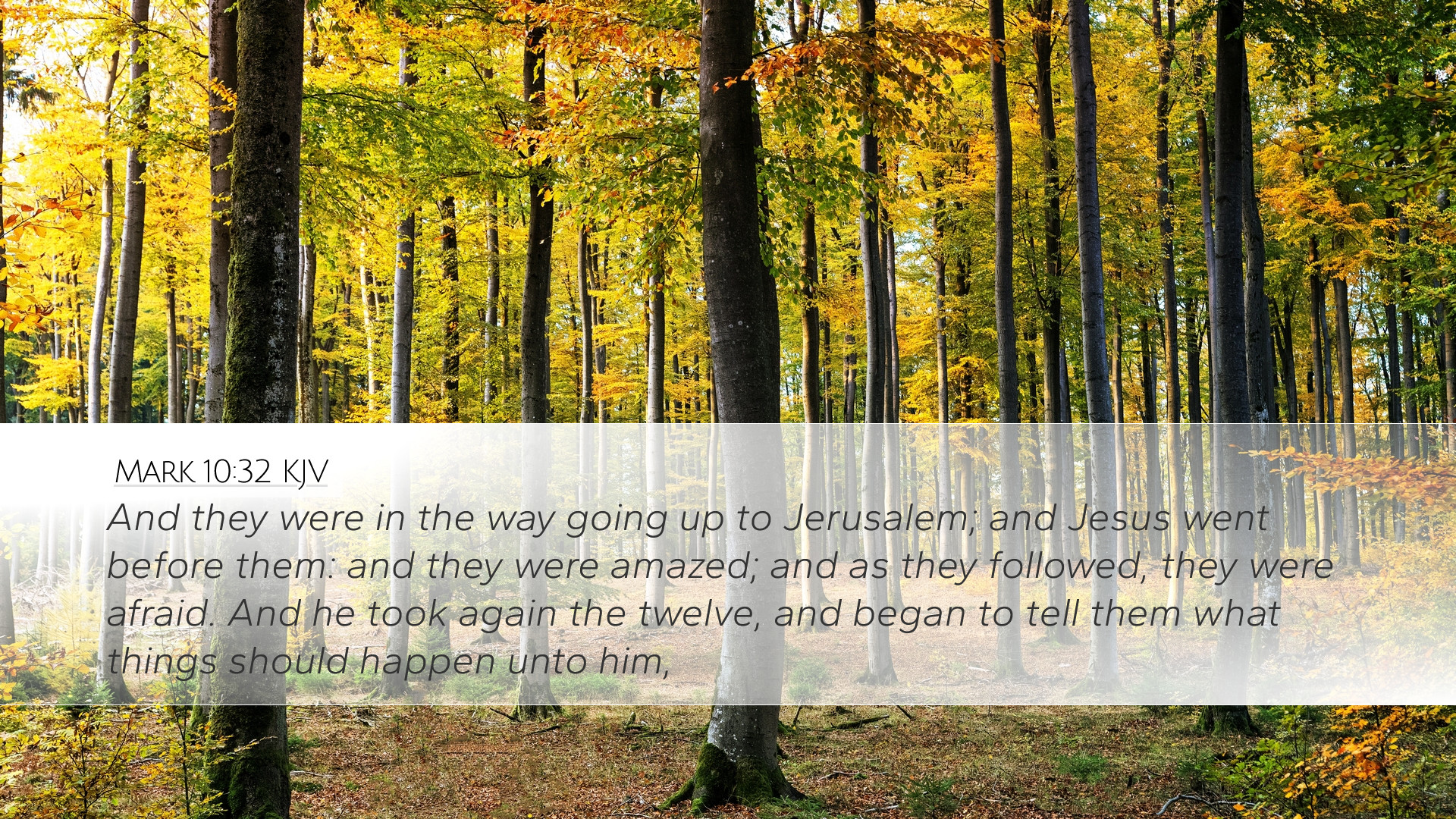Commentary on Mark 10:32
Bible Verse: “And they were in the way going up to Jerusalem; and Jesus went before them: and they were amazed; and as they followed, they were afraid. And he took again the twelve, and began to tell them what things should happen unto him.”
Context and Setting
This verse is pivotal in the Gospel of Mark, occurring in a section where Jesus prepares His disciples for the impending events in Jerusalem. The journey to Jerusalem signifies the culmination of Jesus’ ministry and serves as a backdrop for His teaching about servanthood and sacrifice. The emotional responses of the disciples — amazement and fear — reveal the tension between their expectations of Jesus as the Messiah and the reality of His impending suffering.
Insights from Public Domain Commentaries
Matthew Henry’s Commentary
Matthew Henry emphasizes the significance of Jesus moving ahead of His disciples. This action is not merely physical; it reflects a deeper prophetic gesture, as Jesus deliberately leads them into the path of suffering. His foreknowledge of the trials ahead serves to strengthen the faith of His followers.
- The Journey: Henry notes that the physical journey mirrors a spiritual journey toward understanding Jesus’ mission.
- Emotional Responses: The amazement and fear exhibited by the disciples illustrate their struggle to comprehend Jesus' dual identity as both the triumphant king and the suffering servant.
- Preparation for Suffering: He highlights that in recounting the suffering that awaits Him, Jesus prepares His disciples not only for His death but also for their own trials, emphasizing that a path of discipleship often leads through suffering.
Albert Barnes’ Notes on the Bible
Barnes provides a detailed analysis of the emotional state of the disciples during this journey. He notes the duality of their feelings; they are amazed at Jesus’ authority yet fearful of the implications of His words. This encapsulates the tension in the hearts of early believers.
- Suffering Foretold: Barnes underscores that the specific mention of Jesus’ impending suffering is central to His mission, revealing the paradox of glory through humiliation.
- Teaching Opportunity: This scene serves as a critical moment for Jesus to teach His disciples about the nature of true leadership and sacrifice, describing the challenges they will face as His followers.
- Encouragement in Fear: Jesus’ approach reassures the disciples that understanding the challenges ahead is integral to their growth and faithfulness.
Adam Clarke’s Commentary
Adam Clarke’s exposition highlights the earnestness of Jesus’ intent to clarify His mission to His disciples. His focus is not simply on the destination — Jerusalem — but on the journey's purpose.
- Direction and Leadership: Clarke observes that Jesus leads His followers, signifying His role as a guide in the midst of fear and confusion.
- The Instruction: He stresses that Jesus repeats His teachings about His suffering, indicating the importance of understanding this aspect of His ministry.
- Discipleship and Cost: Clarke reflects on the cost of discipleship, asserting that following Christ entails a readiness to face hostility and misunderstanding akin to what Jesus Himself would endure.
Theological Implications
The emotional reactions of the disciples present ongoing questions about faith and fear in the face of theological truths. The tension they experience serves as a mirror for contemporary believers who also grapple with understanding God's plan amid suffering.
Faith vs. Fear
The phrase “they were afraid” resonates deeply with believers today, reminding us that fear can often accompany profound spiritual truths. It raises essential questions about the nature of faith and the struggle against doubt amidst divine revelation.
Preparation for Ministry
Jesus’ systematic approach to foretelling His death is a foundational teaching for anyone in ministry. Pastors and leaders must prepare their congregations for the reality of sacrifice that accompanies true discipleship, fostering a theology that embraces both glory and suffering.
Servanthood and Sacrifice
Mark 10:32 serves as a preparation for the profound teaching that follows in verses 33-34, where Jesus highlights His purpose as the suffering servant and the redemptive narrative that underpins Christian faith. This understanding is crucial for students of theology to grasp the essential character of Jesus' mission and the call to servanthood in the Christian life.
Conclusion
In summary, Mark 10:32 encapsulates a moment of profound significance. It invites pastors, students, theologians, and scholars to reflect on the nature of leadership, discipleship, and the call to embrace both awe and fear in our journey with Christ. Understanding the depths of Jesus’ revelation prepares us not only for personal faith but also equips us to lead others through the complexities of following a Savior who journeys with us into the heart of suffering and glory.


